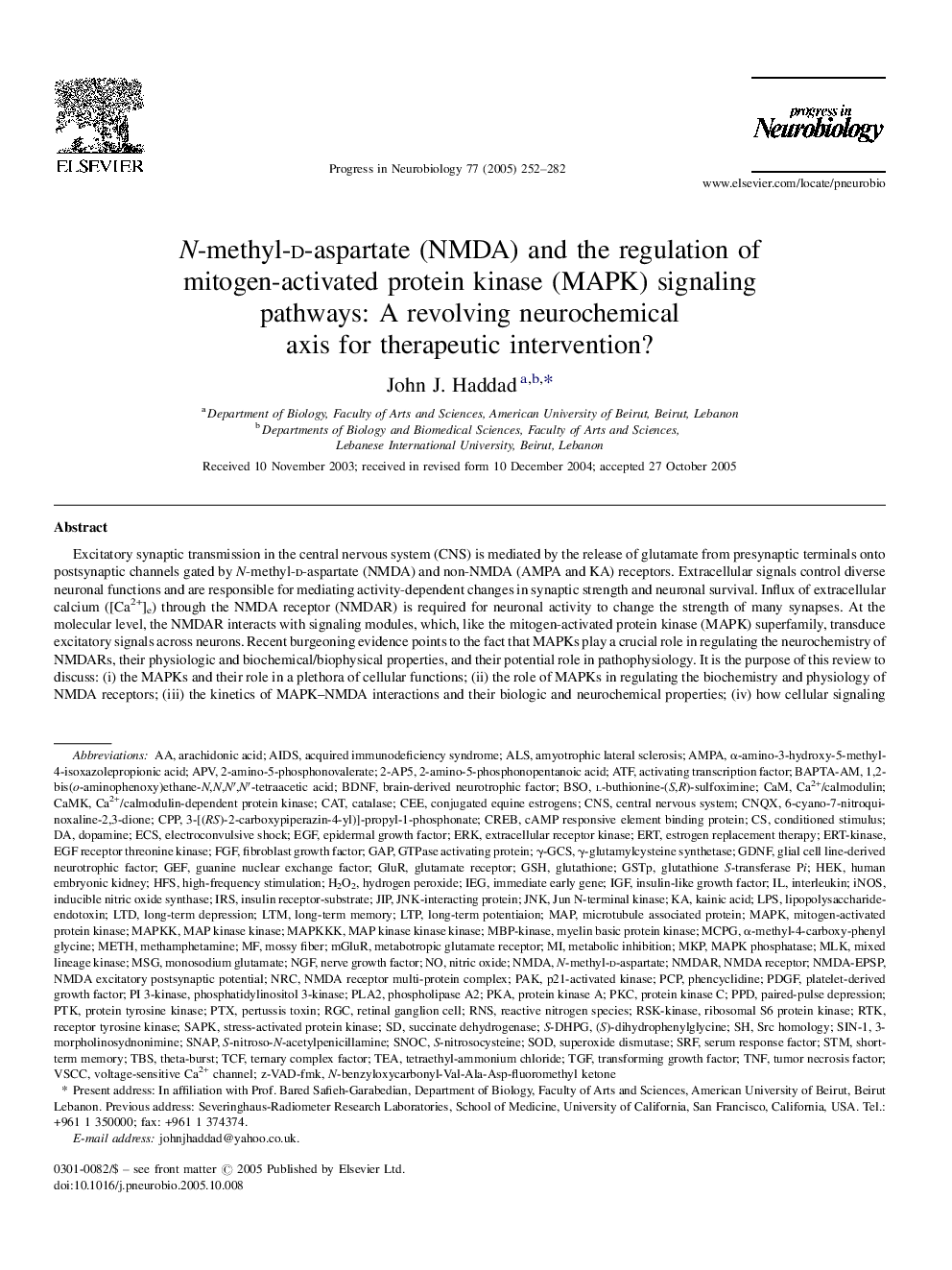| کد مقاله | کد نشریه | سال انتشار | مقاله انگلیسی | نسخه تمام متن |
|---|---|---|---|---|
| 9435137 | 1298555 | 2005 | 31 صفحه PDF | دانلود رایگان |
عنوان انگلیسی مقاله ISI
N-methyl-d-aspartate (NMDA) and the regulation of mitogen-activated protein kinase (MAPK) signaling pathways: A revolving neurochemical axis for therapeutic intervention?
دانلود مقاله + سفارش ترجمه
دانلود مقاله ISI انگلیسی
رایگان برای ایرانیان
کلمات کلیدی
CREBEGFLPSIGFJnkCPPNRCCATGSHHEKATFTBSMSGFGFPCPERKSTMRGCiNOSTCFRNSLTMIRSSRFAMPApKaCaMKNGFNMDAGDNFN-methyl-d-aspartateAPVHFSPKCNMDARGluRPTXmGluRIEGTGFPPDPAKBSOPDGFMAP kinase kinasePLA2GEFMAP kinase kinase kinaseRTKJun N-terminal kinaseGSTPMKPSAPKVSCCSIN-1MCPGγ-GCSSNOCS-nitrosocysteineMAPKKMAPKKKMLKJIPCEEPTKS-nitroso-N-acetylpenicillamineTNFJNK-interacting proteinVoltage-sensitive Ca2+ channelTheta-burstribosomal S6 protein kinase1,2-Bis(o-aminophenoxy)ethane-N,N,N′,N′-tetraacetic acid - 1،2-Bis (o-aminophenoxy) اتان N، N، N '، N'-tetraacetic اسید2-amino-5-phosphonovalerate - 2-آمینو-5-فسفونوالرات2-amino-5-phosphonopentanoic acid - 2-آمینو-5-فسفونوپنتانوئیک اسید3-morpholinosydnonimine - 3-مورفولینویدونیمینیم6-Cyano-7-nitroquinoxaline-2,3-dione - 6-Cyano-7-nitroquinoxaline-2،3-dioneBDNF - BDNF یا فاکتور نورونزایی مشتقشده از مغز Ca2+/calmodulin - Ca2 + / کالمدولینECs - EC هاGTPase Activating Protein - GTPase فعال کردن پروتئینl-buthionine-(S,R)-sulfoximine - L-buthionine- (S، R) -سولفسیمیمMAPK - MAPKMAPK phosphatase - MAPK فسفاتازNMDA receptor - NMDA گیرندهPI 3-kinase - PI 3-کینازz-VAD-fmk - Z-VAD-FMKγ-glutamylcysteine synthetase - γ-گلوتامیل سستئین سینتاتازHydrogen peroxide - آب اکسیژنهphospholipase A2 - آنزیم فسفولیپاز A2 conjugated equine estrogens - استروژن های اسب سواری کانژوگهamyotrophic lateral sclerosis - اسکلروز جانبی آمیوتروفیکα-amino-3-hydroxy-5-methyl-4-isoxazolepropionic acid - اسید α-آمینو 3-هیدروکسی-5-متیل-4-ایزوکسول پپونیکArachidonic acid - اسید آراشیدونیکkainic acid - اسید کرییکlong-term depression - افسردگی طولانی مدتAIDS - ایدزinterleukin - اینترلوکینBAPTA-AM - بیایپیتیای-AMALS - بیماری اسکلروز جانبی آمیوتروفیکtransforming growth factor - تبدیل فاکتور رشدhigh-frequency stimulation - تحریک فرکانس بالاLTP - تقویت طولانی مدت یا LTP long-term memory - حافظه بلندمدتshort-term memory - حافظه کوتاه مدتestrogen replacement therapy - درمان جایگزینی استروژنCNS - دستگاه عصبی مرکزیDopamine - دوپامینpaired-pulse depression - زوج افسردگی پالسBiochemistry - زیستشیمی، بیوشیمی، شیمی حیاتCAM - ساخت به کمک کامپیوترSOD - سدretinal ganglion cell - سلول گانگلیونی شبکیهpertussis toxin - سموم سورافنیinducible nitric oxide synthase - سنتاز اکسید نیتریک القاییacquired immunodeficiency syndrome - سندرم نقص ایمنی به دست آوردSuperoxide dismutase - سوکسوکس دیسموتازsuccinate dehydrogenase - سوکسیناد دهیدروژنازCNQX - سیانکیوایکسcentral nervous system - سیستم عصبی مرکزیSignaling - سیگنالینگelectroconvulsive shock - شوک الکتریکیGAP - شکافSNAP - ضربه محکم و ناگهانیepidermal growth factor - عامل رشد اپیدرمیTernary complex factor - عامل پیچیده سه گانهplatelet-derived growth factor - فاکتور رشد حاصل از پلاکتnerve growth factor - فاکتور رشد عصبfibroblast growth factor - فاکتور رشد فیبروبلاستInsulin-like growth factor - فاکتور رشد مانند انسولینGlial cell line-derived neurotrophic factor - فاکتور نوروتروفی مشتق از سلول گلیاییBrain-derived neurotrophic factor - فاکتور نوروتروفی مشتق شده از مغزtumor necrosis factor - فاکتور نکروز تومورserum response factor - فاکتور پاسخ سرمیPhosphatidylinositol 3-kinase - فسفاتیدیلینواستیل 3-کینازPhosphorylation - فسفریلاسیونactivating transcription factor - فعال کردن عامل رونویسیPhencyclidine - فن سیکلیدین، گرد فرشتهmossy fiber - فیبر قارچMETH - متهMethamphetamine - متیل آمفتامینLTD - محدودconditioned stimulus - محرک شرطیMetabolic inhibition - مهار متابولیکmap - نقشهNeurochemistry - نورو شیمیNitric oxide - نیتریک اکسیدERT - هستندSrc homology - همخوانی SrcH2O2 - هیدروژن پراکسیدPathophysiology - پاتوفیزیولوژیcAMP responsive element binding protein - پروتئین اتصال دهنده عنصر پاسخ دهنده cAMPProtein tyrosine kinase - پروتئین تیروزین کینازmicrotubule associated protein - پروتئین مرتبط با میکروتوبولprotein kinase A - پروتئین کیناز AProtein kinase C - پروتئین کیناز سیmitogen-activated protein kinase - پروتئین کیناز فعال با mitogenStress-activated protein kinase - پروتئین کیناز فعال شده با استرسCa2+/calmodulin-dependent protein kinase - پروتئین کیناز وابسته به کلسیم و پتاسیم Ca2 + /myelin basic protein kinase - پروتئین کیناز پایه میلینTEA - چایimmediate early gene - ژن فوری اولیهCatalase - کاتالازCalcium - کلسیمhuman embryonic kidney - کلیه جنین انسانKinase - کینازp21-activated kinase - کیناز فعال p21mixed lineage kinase - کیناز قارچ مخلوطextracellular receptor kinase - کیناز گیرنده خارج سلولیGlutathione - گلوتاتیونGlutathione S-transferase Pi - گلوتاتیون S-انتقالزا Piglutamate - گلوتاماتmonosodium glutamate - گلوتامات monosodiumreactive nitrogen species - گونه های واکنش پذیر نیتروژنReceptor Tyrosine Kinase - گیرنده تیروزین کینازMetabotropic glutamate receptor - گیرنده گلوتامات متابوتروپیکGlutamate receptor - گیرنده گلومات
موضوعات مرتبط
علوم زیستی و بیوفناوری
علم عصب شناسی
علوم اعصاب (عمومی)
پیش نمایش صفحه اول مقاله

چکیده انگلیسی
Excitatory synaptic transmission in the central nervous system (CNS) is mediated by the release of glutamate from presynaptic terminals onto postsynaptic channels gated by N-methyl-d-aspartate (NMDA) and non-NMDA (AMPA and KA) receptors. Extracellular signals control diverse neuronal functions and are responsible for mediating activity-dependent changes in synaptic strength and neuronal survival. Influx of extracellular calcium ([Ca2+]e) through the NMDA receptor (NMDAR) is required for neuronal activity to change the strength of many synapses. At the molecular level, the NMDAR interacts with signaling modules, which, like the mitogen-activated protein kinase (MAPK) superfamily, transduce excitatory signals across neurons. Recent burgeoning evidence points to the fact that MAPKs play a crucial role in regulating the neurochemistry of NMDARs, their physiologic and biochemical/biophysical properties, and their potential role in pathophysiology. It is the purpose of this review to discuss: (i) the MAPKs and their role in a plethora of cellular functions; (ii) the role of MAPKs in regulating the biochemistry and physiology of NMDA receptors; (iii) the kinetics of MAPK-NMDA interactions and their biologic and neurochemical properties; (iv) how cellular signaling pathways, related cofactors and intracellular conditions affect NMDA-MAPK interactions and (v) the role of NMDA-MAPK pathways in pathophysiology and the evolution of disease conditions. Given the versatility of the NMDA-MAPK interactions, the NMDA-MAPK axis will likely form a neurochemical target for therapeutic interventions.
ناشر
Database: Elsevier - ScienceDirect (ساینس دایرکت)
Journal: Progress in Neurobiology - Volume 77, Issue 4, November 2005, Pages 252-282
Journal: Progress in Neurobiology - Volume 77, Issue 4, November 2005, Pages 252-282
نویسندگان
John J. Haddad,